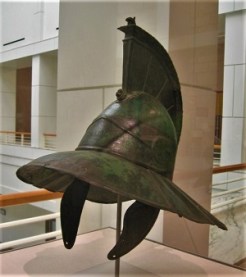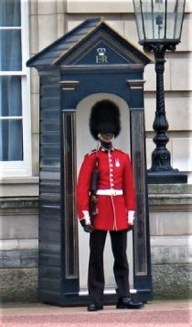Today on Museum Bites we’re suiting up for battle in Part 2 of our look at headgear. Whether it be for fire or foe, some of the more unusual helmets and hats I’ve come across in my travels were created for combat. We’ll start our tour deep inside the Michigan State University Museum.

Battling to Breathe: When I first stumbled across the Vajen-Bader Smoke Protector, I initially thought it was a prop from Dr. Who or Star Wars. This bizarre looking hood was created in the 1890s by hardware salesman, Willis Vajen and piano maker, William Bader to prevent the inhalation of smoke and toxic fumes. A precursor to the gas mask, Vajen and Bader loaded this model with a variety of bells and whistles. A canister on the back pumps air into the mask, and the eye and earholes are covered in a thermal protectant of mica.

The eyeholes also come with mini windshield wipers. Just turn the tiny knobs located on the center of each eyehole to swish away any condensation. Since communication was difficult when wearing one of these contraptions, the inventors added a whistle mouthpiece. A series of toots and hoots alerted others to any danger. Click on this link for a brief demonstration of the Vajen-Bader Helmet.

On a side note, I came across these modern day “smoke protectors” in my hotel room during a recent trip to China. I wasn’t sure if I should be alarmed or relieved by their presence. I do know that a whistle and mini windshield wipers would be worthwhile additions 😉

Battling for Rome: This gladiator helmet comes to us from ancient Rome and is currently on display at the Detroit Institute of Arts. Made from a thin layer of bronze and sporting a crest that once held a brilliant plume of dyed horsehair, this helmet was more about style than protection. Gladiators were the World Wrestling Entertainment (WWE) of ancient Rome. Their ranks included a colorful cast of characters and costumes, but unlike today the gladiator games were bloody, brutal and almost always fatal.

The first Roman gladiator contest took place in 264 BCE when two sons organized a match in honor of their recently deceased father. These showy tournaments gradually gained in popularity. Gladiator training schools opened, competitors began to specialize in tactics and armor, and the victors earned celebrity status. The gladiator games were officially retired in 404 CE when Roman Emperor, Honorius outlawed the contests. Click on this link to watch ancient Rome expert, Mary Beard discuss the “weirdness” of the Roman Gladiator helmet.

Battling the Russians: Napoléon Bonaparte’s (1769—1821) bicorne chapeau is as famous as the man himself. An estimated 120 of these handmade, felt hats were created for the Little Corporal and legend has it, his valet was responsible for breaking in each new version. The bicorne was typically worn front-to-back but Napoléon wore his in a rakish side-to-side fashion. He performed this revolutionary alteration in an effort to be better noticed on the battlefield. The chapeau featured here, is on display at the Montreal Museum of Fine Art. It is one of just 19 surviving hats and was worn during Napoléon’s fateful Russian campaign of 1812.

The French general and his Grand Armée invaded Russia in the summer of 1812. Originally allied with France, Tsar Alexander I (1777-1825), drew Napoléon’s troops deeper and deeper into Russia through blistering heat and eventually an early and brutal winter. The Russians abandoned their cities, burned their crops and left Napoleon and his troops farther afield. Supply lines dwindled, French troops perished or deserted and a frustrated Napoléon and his très chic bicorne were forced to retreat. Click on this History Channel clip if you’d like to learn more.

Battling the Gate Crashers: Our final battle helmet comes from merry old England but has its roots in France. After defeating the Grand Armée at the Battle of Waterloo, British troops nicked the bearskin hats worn by Napoléon’s imperial guard. Once back in England, the troops paraded through the streets flaunting their victory and newfound spoils of war. The furry style caught on and today the towering (18 inches) and controversial bearskin is the trademark of the British Queen’s Guard. Known for their bright red coats and stoicism these soldiers protect all six of Queen Elizabeth II’s residences.

Made from Canadian black bear fur, the bearskins have kicked up some controversy. Animal rights organizations—most notably, the People for the Ethical Treatment of Animals (PETA) naked demonstration—have long protested the slaughter of black bears for the purpose of what is a ceremonial, and let’s face it, not very functional hat. Attempts have been made to substitute a synthetic version but to this day, the Queen’s Guard still sport authentic bearskin. Click on this link to see the bearskin and Queen’s Guard in action during the annual Trooping the Colour.
That wraps up our look at battle headgear. Next week, we’ll be putting the kettle on to boil and venturing into the history of teapots. Have a great week!
Sources:
History.com – Napoleon Invades Russia
History.com – Klein, C. (2014), Napoleon’s Hat Fetches $2.4 Million at Auction.
